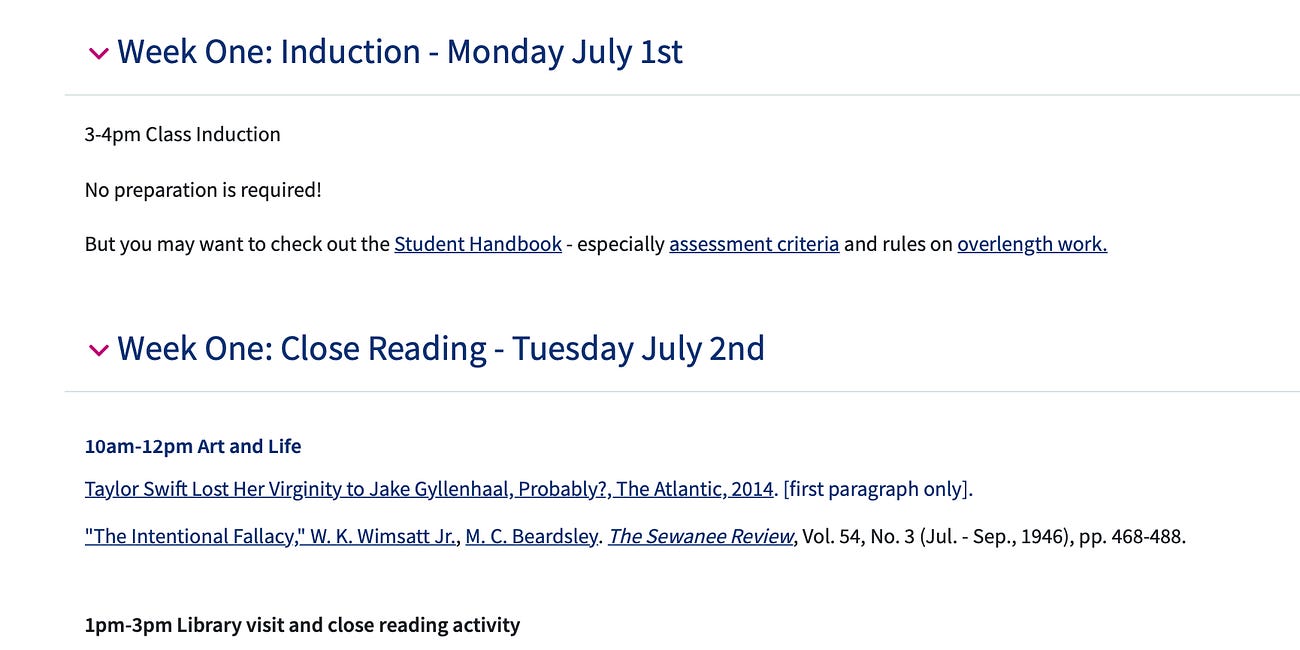Taylor Swift will give her first London concert of the Eras Tour tonight. This AP News article asks the big question: given that she has a song called “So Long, London,” is she ever coming back? The answer, unsurprisingly, is that she is coming back in August when she has more shows scheduled. When I read this kind of thing, I just want to shake people and be like “come on, it’s art” - her song doesn’t mean she’s literally saying goodbye to London. In fact I’m pretty sure London in that song is a synecdoche in the somewhat less common meaning of a whole representing a part - she is saying goodbye to the “London Boy” and calling him London. I think you could interpret the song as being about throwing the bathwater out with the baby: having to leave the city because you left the boy. But still, that’s not a real statement about her intentions, it’s art.
Shaking people and screaming “it’s art” is basically the abstract of my book.
Anyway, speaking of leaving London, I am in New York. (My flight over was filled with people coming back from the Eras Tour - a lot of people were wearing Eras Tour merch, and one person was wearing what looked like The Black Dog merch).
I enjoyed reading this article on live fan broadcasts of the Eras Tour, but I will not be tuning in. I did go to see the revival of Merrily We Roll Along at the Hudson Theatre yesterday. It’s a difficult musical. I’ve always been really curious to see it performed. I do think the second half (which comes first chronologically) is better, in part because it contains the excellent number “Opening Doors.” I will take pretty much any Sondheim musical and I think this one is, if not as good as Company or Follies, at least an interesting experiment in form. They were filming the performance I attended so I think a recorded version will be out at some point. Anyway, sooner than the Richard Linklater movie that’s scheduled to come out in the 2040s.
I’ve been planning this year’s iteration of my summer school module, Taylor Swift and Literature, which starts on July 1st. This is the second year it’s running and like last year the class is designed to function partly as an introduction to the practice of English as a discipline, starting with close reading in week one, moving on to analyzing critics in week two, and setting aside week three for thinking about how to do criticism beyond the academy - public scholarship, exhibitions, social media, etc. Of course, it’s also specifically about the question of what it means to study Swift as literature, and whether this forces us to expand our understanding of what literature is and how it works. I was initially a little uncertain how to organize it: because of the way the summer school is set up, the class runs over just three weeks, but with four hours of teaching a day, four days a week. You can’t ask people to do a huge amount of reading in these circumstances, and you don’t want four hours of seminar discussions a day - I think two hours a day is pretty much the limit. So I tried to balance independent research time, field trips, and activities with classroom time. If you’re curious what that looks like, you can find the syllabus here:
"Taylor Swift and Literature" syllabus
Because I am sometimes asked what I teach in my Taylor Swift and Literature class at the Queen Mary University of London summer school, I’ve attached a snapshot of the syllabus for this year’s iteration. This may change as the class goes on!
.
One of the things I’ve been thinking about is how much to incorporate London itself in the class. The module is aimed at international students, so it’s nice to bring the city into the discussion. But I am skeptical to what extent being in London does in fact help us understand Swift’s work, despite the many mentions of the city in her lyrics. Going to The Black Dog might help us understand Swift’s fans and how they engage with her music. But so would just talking about why people want to go there. (I walked past The Black Dog last week and it was too crowded to go in, so I feel I’ve done my duty re The Black Dog). I ended up deciding to take the students on a tour of Highgate Cemetery instead, a place where many prominent London residents are buried, from Karl Marx to George Eliot. I think this should prompt a conversation about how and when you should take an author’s geographical situation into account, as well as a conversation on legacy: how will Swift be remembered? As an artist who lived in and wrote about London? Anyway, Swift mentions Highgate (the place, not the cemetery) in “London Boy,” and we can go to Hampstead Heath afterwards, which she also mentions. We’re also going to the British Library, to see an exhibition on Black British music that looks really interesting and their permanent Treasures Gallery exhibition to see things like their Beatles memorabilia.
I’m looking forward to all of this! It’s always bittersweet teaching in summer, when I really need the research time, but at least the teaching and research are on the same subject.





